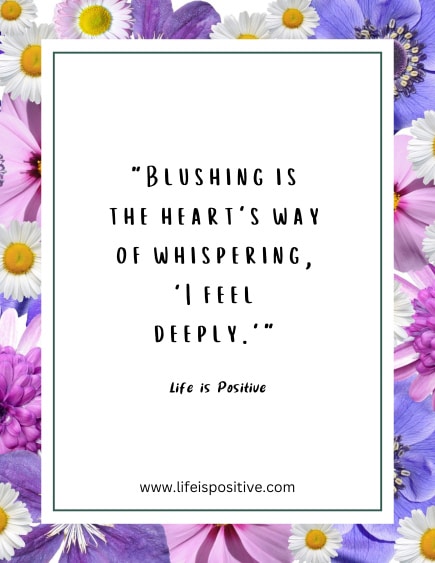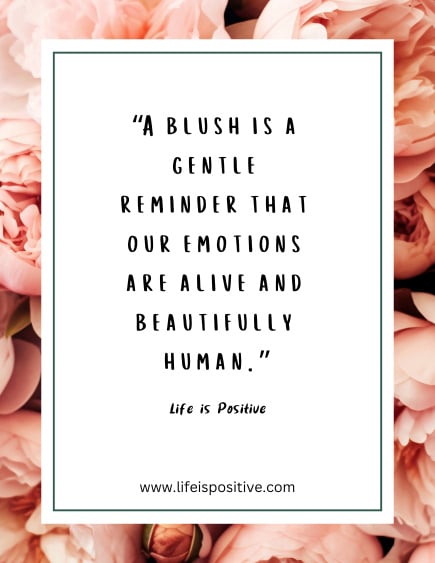|
Getting your Trinity Audio player ready...
|
Ever catch yourself with rosy cheeks at the most random times? Maybe someone threw you a compliment, or you took a tumble in front of a crowd.
No matter the cause, you’re blushing, and it’s that totally natural (yet sometimes awkward) response we all know too well.
But have you ever stopped to think about why it happens? Let’s dive into the fascinating science of blushing and see what those pink cheeks are really up to!
What is Blushing?
Blushing is just your face’s way of throwing a mini party due to a rush of blood flow.
It usually pops up when we’re feeling those big emotions—think embarrassment, shyness, or even those butterflies when you have a crush.
But what’s the deal? Why does this happen, and what’s the point of it all? Let’s break it down!
Read: 12 Signs You’re Smarter Than You Realize
The Science of Blushing
When you’re blushing, your body is responding to a trigger. This trigger could be emotional stress, social attention, or even a compliment.
The process starts in your brain, specifically in the hypothalamus, which controls your autonomic nervous system.
How It Works:
• Emotional Trigger: When you experience an emotional trigger, your brain sends a signal to your body.
• Adrenaline Release: The adrenal glands release adrenaline into your bloodstream.
• Vasodilation: Adrenaline causes the blood vessels in your face to dilate, increasing blood flow to the skin.
• Rosy Cheeks: The increased blood flow gives your cheeks that characteristic red hue.
So, when you’re blushing, it’s actually your body’s way of responding to social and emotional stimuli. It’s a complex physiological reaction that involves your brain, hormones, and blood vessels.
Read: What is DRESS Syndrome?
Why Do We Blush?
You’re blushing for a reason, and it’s not just because you forgot your sunscreen! But what’s the evolutionary deal with blushing?
Scientists think it’s all about our social game and how we communicate. So, those rosy cheeks aren’t just for show—they’re part of our way of connecting with others!
1. Nonverbal Apology: Blushing can act as a nonverbal apology. It signals to others that you recognize a social faux pas or mistake, which can help smooth over social interactions.
2. Building Trust: Blushing can make you appear more honest and trustworthy. When you’re blushing, it shows vulnerability, which can foster empathy and understanding from others.
3. Attraction: Blushing can also signal romantic interest or attraction. It’s a way of nonverbally expressing your feelings without saying a word.
The Psychology of Blushing
Understanding why you’re blushing involves delving into the psychology behind it. Blushing is closely linked to our emotions and how we perceive ourselves in social contexts.
Self-Consciousness: Blushing often occurs when we become acutely aware of ourselves and how others perceive us. This heightened self-consciousness can trigger the blush response.
Social Norms: Cultural and social norms also play a role. In some cultures, blushing might be seen as a sign of modesty or respect, while in others, it could be a sign of weakness.
Read: Stop 10 Compliments For Women
Managing Blushing
While blushing is totally natural, it can be a bit bothersome—especially when it strikes at the worst possible moments. If you find yourself turning red more often than you’d like, here are some handy tips to help manage that blush:
• Deep Breathing: Practice deep breathing exercises to calm your nerves and reduce the likelihood of blushing.
• Stay Cool: Keeping your body cool can help minimize blushing. Drink cold water or use a fan to cool down.
• Positive Self-Talk: Reassure yourself that blushing is normal and nothing to be embarrassed about.
• Mindfulness: Practice mindfulness to stay grounded in the moment and reduce anxiety.
• Seek Professional Help: If blushing is significantly affecting your life, consider speaking with a therapist or counselor.
Read: 13 Little Compliments You Should Give
Fun Facts About Blushing
To lighten things up, here are some fun and interesting facts about blushing:
• Unique to Humans: Blushing is unique to humans. No other animal blushes like we do.
• Charles Darwin’s Observation: Charles Darwin called blushing “the most peculiar and most human of all expressions.”
• Involuntary Reaction: You can’t control when you blush. It’s an involuntary response, making it all the more intriguing.
• Universal Response: People all over the world blush, regardless of culture or background.
Final Thoughts: You’re Blushing
The next time you feel that telltale warmth creeping into your cheeks, remember that blushing is just a natural human reaction. It’s a little reminder of your sensitivity and emotional depth, so why not embrace it?
When those rosy cheeks make an appearance, just know you’re experiencing one of the most wonderfully human reactions out there. So, rock that blush with pride!
Don’t shy away from showing off those flushed cheeks. After all, blushing is a beautiful part of being human, and it just means you’re feeling something real!
For more empowering content, connect with our vibrant community here ➡️ Social Media


